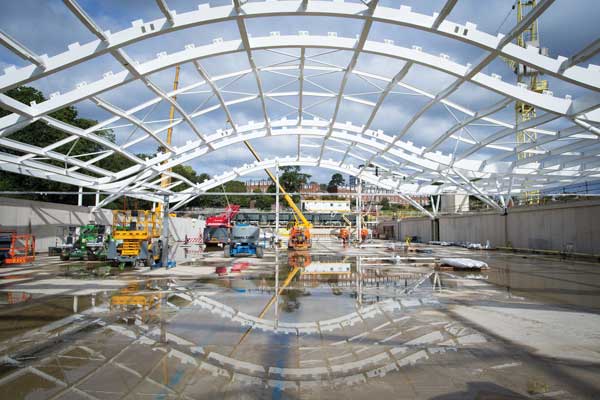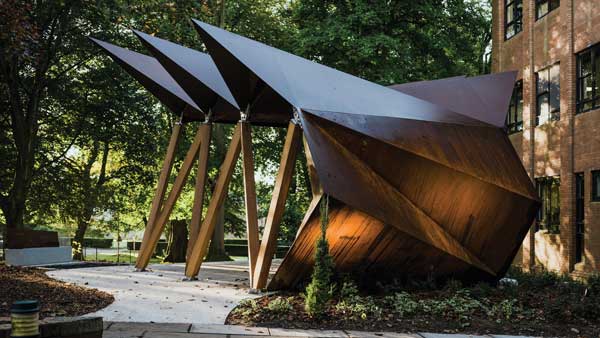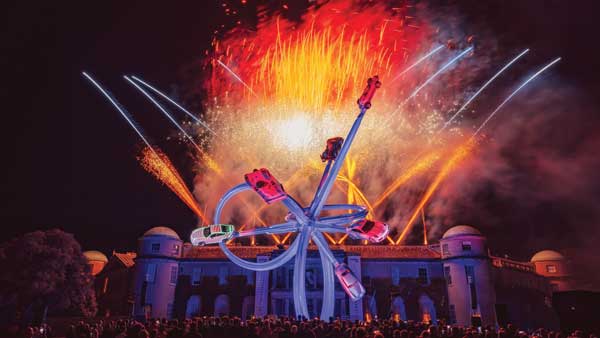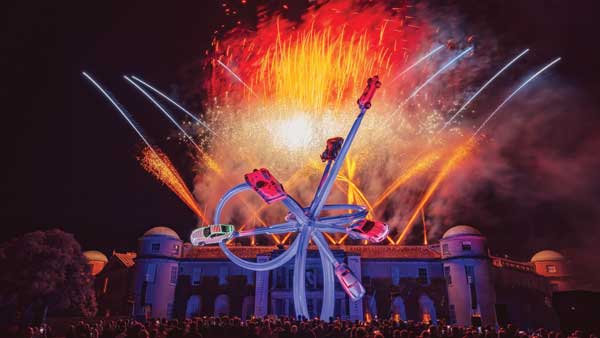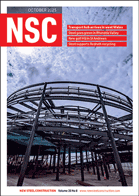SSDA Awards
AWARD – The Porsche Sculpture at the 2023 Goodwood Festival of Speed
A complex sculpture, supporting six Porsche sports cars, is an exemplary application of steelwork efficiency and design.
FACT FILE
Artist: Gerry Judah Ltd
Structural engineer: Diales
Main contractor: Littlehampton Welding Ltd
Client: Goodwood Festival of Speed
A selection of six valuable cars, suspended from an intricate and complex steel sculpture, provided one of the highlights of the 2023 Goodwood Festival of Speed.
Containing 40t of steelwork, the Porsche Sculpture was installed to commemorate 75 years of the German manufacturer’s sports cars.
Standing 25m-tall, the cantilevered structure includes three interconnected hoops and six spars that supported the Porsches, which ranged in age from a 1951 model up to and including a contemporary car.
Designed, fabricated and installed within a tight 28-week delivery timeframe, the project needed materials that were readily available. Using laser-cut plate and induction-rolled circular tube sections fitted the bill as they were readily available from stock.
Steel proved to be significantly more cost-effective than alternative materials and offers the added benefit of being fully recyclable at the end of the sculpture’s lifetime. From an installation perspective, the project required site welding, which would have been considerably more difficult with materials like aluminium.
The material’s availability, cost-effectiveness, structural performance, and fabrication flexibility made steel the ideal choice for delivering this sculpture project within the demanding timeframe and budget constraints.
The design used integrated computational workflow and custom 3D modelling software, which enabled rapid assessment of deflections, frequencies and stress distributions throughout the design process.
“The technical challenges were all related to the complex geometry and achieving the required aesthetic quality. The central hub is a dodecahedron that needed to interface with twelve tubes of two different diameters,” explains Diales’ Associate Director Bruno Postle.
“The hub required the necessary strength to transmit all of the loads, while also being buildable with all interfaces positioned at the correct angles and locations. It also needed to look good.”
Steelwork was the natural choice for the sculpture as no other material could provide the same combination of strength, affordability, and adjustability.
Steel’s ability to be reworked allows it to be shaped into the necessary complex forms required for the sculpture. While alternative materials could theoretically have been used, they would not have provided the same strength and would be vulnerable to impact damage, while lacking the adjustability needed to create the required forms.
While pre-cast concrete would theoretically be strong enough, it would be many times heavier, resulting in unacceptable dynamic behaviour. Modern paint systems and corrosion protection make steel an excellent material for durability and long-term weather exposure in outdoor installations.
Another engineering challenge was developing a stable cantilevered structure, with a low mass distribution at height, that would manage dynamic response.
Dynamic loads, such as those produced by gusts of wind, will introduce twisting forces to a structure if its centre of mass and stiffness do not coincide.
Variable thicknesses of the structural elements (20mm plate at critical junctions, tapering to 4mm plate in less stressed areas) optimised the weight and distribution of the sculpture.
The sculpture was fabricated in Littlehampton, only 15km from the installation site. The compressed timeline required concurrent design and fabrication, with late design changes needing to be implemented during the production process.
Once the fabrication process was complete, the entire sculpture was trial assembled in order to make sure every part fitted together exactly. It was then disassembled and transported to site.
The hoops, which were too big to be delivered to site as complete pieces, arrived onsite in three sections. The spars, with the longest measuring approximately 16.5m-long, arrived preassembled in single pieces.
Once they were at Goodwood, the sections were re-assembled, using a custom-designed rigging system and two cranes, which were required to complete the precise positioning of the sculpture’s steel elements.
To maintain the structural stability throughout the erection programme, the base and hub were installed first, then the spars with their pre-attached vehicles and finally the suspended hoops. Safety protocols were established for all lifting operations, not just because these involved valuable historic cars. The final installation deadline was immovable due to the festival opening date.
The project incorporated several environmental considerations in its engineering approach. Material usage was optimised through iterative analysis, reducing steel quantity by approximately 33% from initial estimates.
After the festival, the sculpture was disassembled in the reverse order of assembly (a procedure made possible as the sculpture has bolted connections wherever possible), and it is now in storage, awaiting its next festival appointment.
In summary, the judges say the sculpture, which displays a number of original Porsche sports cars on cantilevered arms, exemplifies the extraordinary flexibility of steel as a material. It is a visually exciting, dynamic form that has been cleverly engineered, carefully detailed and skilfully fabricated – the result of a true team effort.


